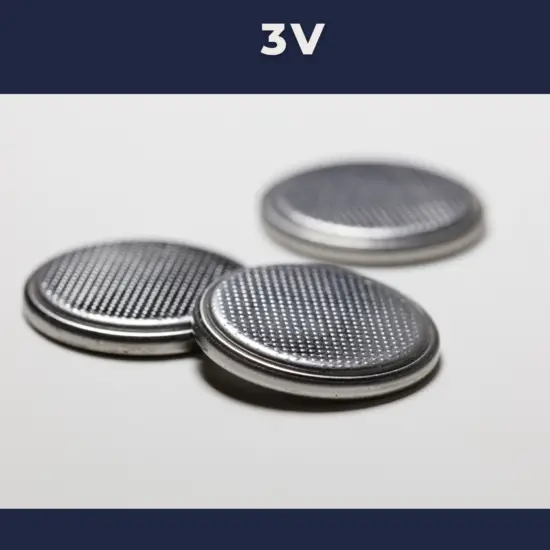30-second summary
3V Battery
The voltage of electric batteries is determined by:
- Chemistry. The potential difference of the materials that compose the positive and negative electrodes in the electrochemical reaction.
- Number of cells. Batteries in series produce a voltage equal to the number of batteries multiplied by the voltage of each individual battery.
It doesn’t matter what format the battery is. For example, an AA battery with the same chemistry has the same voltage as an AAA battery.
3V batteries are usually based on lithium metal technology. The most commonly used 3V batteries are button cells based on lithium-manganese dioxide cells.
The most common cells are summarized below:
- Lithium-Manganese Dioxide Cell.
- Lithium Thionyl Chloride Cell.
- Lithium Air Cell.
Overall reaction (Li/MnO2 cells):
Li(s) + MnIVO2(s) ⇌ MnIIIO2(Li+) [E° = +3.19 V]

An electric battery is essentially a source of DC electrical energy. It converts stored chemical energy into electrical energy through an electrochemical process. This then provides a source of electromotive force to enable currents to flow in electric and electronic circuits. A typical battery consists of one or more voltaic cells.
The voltage of electric batteries is determined by:
- Chemistry. The potential difference of the materials that compose the positive and negative electrodes in the electrochemical reaction.
- Number of cells. Batteries in series produce a voltage equal to the number of batteries multiplied by the voltage of each individual battery.
The voltage of electric batteries is created by the potential difference of the materials that compose the positive and negative electrodes in the electrochemical reaction.
3V Battery – Lithium Primary Battery
Lithium-based primary cells are batteries that have metallic lithium as an anode. These types of batteries are also referred to as lithium-metal batteries. Note that disposable primary lithium batteries must be distinguished from secondary lithium-ion or lithium-polymer, which are rechargeable batteries. Lithium-ion batteries do not contain metallic lithium.
Primary lithium batteries have the lowest self-discharge rate hence the longest available shelf time, up to 10 years, and in temperatures up to 70. The first letter in the IEC standard system identifies the battery’s chemical composition. C is for lithium metal batteries (as CR2032). The characteristics that make lithium an exceptional electrode material for high energy density batteries include low electrode potential and very high conductivity. It is soft and malleable and can be extruded into thin foils.
They may be classified in several ways, but one convenient method is by the cathode material and voltage. Using an iron disulfide cathode gives a battery with a nominal voltage of 1.5 volts. This cell is used for high-performance AA batteries. Most other lithium batteries are 3.0 volt systems using cathodes comprising either solids (manganese dioxide or carbon monofluoride) or highly toxic liquids (sulfur dioxide or thionyl chloride).
Types of Lithium Metal 3V Batteries
The most common cells are summarized below:
- Lithium-Manganese Dioxide Cell. This cell uses lithium foil as the anode and manganese dioxide as the cathode. The electrolyte is a separator sheet impregnated with electrolytic salts. The overall cell voltage is 3 volts. It is the most common non-rechargeable lithium cell commonly used in button cells like CR2032.
- Lithium Iron Disulphide Cell. Cylindrical lithium iron disulfide batteries (LiFeS2) use lithium for the anode, iron disulfide for the cathode, and a lithium salt in an organic solvent blend as the electrolyte. Designed to be a drop-in replacement for Zinc-carbon or alkaline batteries, the cell voltage is 1.5 volts. They are often called “voltage-compatible” lithium cells. They have a higher energy density than the cells they replace and are tailored to high current applications. They are also produced in the AA battery format.
- Lithium Thionyl Chloride Cell. This type of cell has the highest energy density of all lithium-type cells and has a service life of 15 to 20 years.
- Lithium Air Cell. Similar to zinc-air cells, they have a very high theoretical energy density. The anode, a metallic lithium foil pressed into a nickel mesh current collector, is electrochemically coupled to an unlimited supply of atmospheric oxygen through an air cathode.
Disposable primary lithium batteries must be distinguished from secondary lithium-ion or lithium-polymer, which are rechargeable batteries.
Cell Voltage

The voltage of electric batteries is created by the potential difference of the materials that compose the positive and negative electrodes in the electrochemical reaction.
The voltage produced by each lithium-ion cell is about 3.6 volts. This has many advantages. Being higher than that of the standard nickel-cadmium, nickel metal hydride, and even standard alkaline cells at around 1.5 volts and lead acid at around 2 volts per cell, the voltage of each lithium-ion cell is higher, requiring fewer cells in many battery applications.
Because most of the resulting voltages are around 2V, cells are connected in series to obtain more practical electrical potentials (i.e. 2V lead acid cells are connected in series to obtain a typical 12V battery).
Batteries with voltages greater than 1.5 volts are usually made up of cells connected in series inside a single case. In the 9 volt battery, there are six cells connected in series. The calculation is 6 × 1.5 Volt = 9 Volt.
To know the voltage of a battery, batteries are marked with nominal voltages which is the average voltage a cell outputs when is fully charged, but this may differ from the open circuit voltage.
In addition, some factors like low temperature can decrease the expected voltage output and increase with higher temperature, which is favorable for the electrochemical reactions.
To avoid batteries to discharge below a certain level which could cause damaging the battery, there is a voltage limit called cut-off voltage.
- 1.5V (DC) – A common open circuit voltage for non-rechargeable alkaline batteries (e.g. AAA, AA and C cells).
- 3V (DC) – Lithium-based primary cells are batteries that have metallic lithium as an anode. The voltage of most lithium-metal cells (e.g. button cells) is 3V.
- 3.8V (DC) – Almost all lithium-ion batteries work at 3.8 volts. In order to make current flow from the charger to the battery, there must be a potential difference. Therefore battery chargers or USBs for almost all smartphones provide a voltage of 5V.
- 12V (DC) – A common voltage for automobile batteries is 12 volts (DC). But this battery consists of six 2V lead cells.
Other Types of Batteries
The following list summarizes notable electric battery types composed of one or more electrochemical cells. Four lists are provided in the table. The first list is a battery classification by size and format. Then, the primary (non-rechargeable) and secondary (rechargeable) cell lists are lists of battery chemistry. The third list is a list of battery applications. The final list is a list of different battery voltages.
Sizes
- AA battery
- AAA battery
- AAAA battery
- C battery
- D battery
- cr1220 battery
- cr1620 battery
- cr1632 battery
- cr1616 battery
- cr2016 battery
- cr2032 battery
- cr2025 battery
- cr2430 battery
- cr2450 battery
- cr123 battery
- cr2 battery
- cr132a battery
- lr1130 battery
- lr41 battery
- lr44 battery
- A23 battery
- a13 battery
- 18650 battery
- 21700 battery

